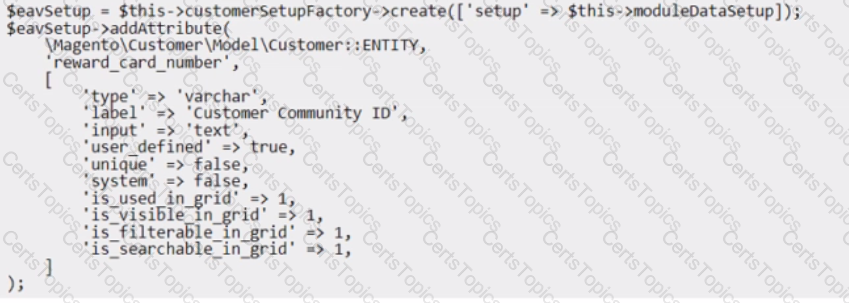An Adobe Commerce Architect designs a data flow that contains a new product type with its own custom pricing logic to meet a merchant requirement. Which three steps are required when adding a product type with custom pricing? (Choose three.)
An Adobe Commerce Architect is planning to create a new action that will add gift registry items to the customer's quote. What should the Architect do to guarantee that private content blocks are updated?
A representative of a small business needs an Adobe Commerce Architect to design a custom integration of a third-party payment solution. They want to reduce the list of controls identified in their Self-Assessment Questionnaire as much as possible to achieve PCI compliance for their existing Magento application.
Which approach meets the business needs?
While reviewing a newly developed pull request that refactors multiple custom payment methods, the Architect notices multiple classes that depend on \Magento\Framework\Encryption\EncryptorInterface to decrypt credentials for sensitive data. The code that is commonly repeated is as follows:

The Architect needs to recommend an optimal solution to avoid redundant dependency and duplicate code among the methods. Which solution should the Architect recommend?
An Adobe Commerce Architect is asked by a merchant using B2B features to help with a configuration issue.
The Architect creates a test Company Account and wants to create Approval Rules for orders. The Approval Rules tab does not appear in the Company section in the Customer Account Menu when the Architect logs in using the Company Administrator account.
Which two steps must be taken to fix this issue? (Choose two.)
A merchant is utilizing an out-of-the-box Adobe Commerce application and asks to add a new reward card functionality for customers. During the code review, the Adobe Commerce Architect notices the reward_card_number attribute setup created for this functionality is causing the customer attribute to be unavailable in the My account/My rewards page template.

What should be added to set the customer attribute correctly?
A client is migrating to Adobe Commerce Cloud and has approximately 800 existing redirects that must be implemented. The number of redirects cannot be reduced because all redirects are specific, and do not match any pattern.
How should the redirects be configured to ensure performance?
An Adobe Commerce Architect needs to ensure zero downtime during the deployment process of Adobe Commerce on-premises. Which two steps should the Architect follow? (Choose two.)
An Adobe Commerce Architect is troubleshooting an issue on an Adobe Commerce Cloud project that is not yet live.
The developers copied the Staging Database to Production in readiness to Go Live. However, when the developers test their Product Import feature, the new products do not appear on the front end.
The developers suspect the Varnish Cache is not being cleared. Staging seems to work as expected. Production was working before the database migration.
What is the likely cause?
A client has multiple warehouses where orders can be fulfilled. The cost of shipping goods from each warehouse varies by day, due to the number of workers available. The Architect needs to make sure that when an order is shipped, it is shipped from the lowest cost warehouse that is open.
How should this functionality be implemented?
An Adobe Commerce Architect notices that the product price index takes too long to execute. The store is configured with multiple websites and dozens of customer groups.
Which two ways can the Architect shorten the full price index execution time? (Choose two.)
An Adobe Commerce Architect is reviewing API-functional test code. Some tests send errors to indicate that the customer address does not exist. The test codes show the following:

Which step should the Architect take to fix the test errors?
A merchant asks for a new category attribute to allow uploading an additional mobile image against categories. The merchant utilizes the content staging and preview feature in Adobe Commerce and wants to schedule and review changes to this new mobile image field.
A developer creates the attribute via a data patch and adds it to view/adminhtml/ui_component/category_f orm. xml. The attribute appears against the category in the main form, but does not appear in the additional form when scheduled updates are made.
To change this attribute when scheduling new category updates, which additional action should the Architect ask the developer to take?
An Adobe Commerce Architect is creating a new GraphQL API mutation to alter the process of adding configurable products to the cart. The mutation accepts configurable product ID. If the given product has only one variant, then the mutation should add this variant to the cart and return not nullable Carttype. If the configurable product has more variants, then the mutation should return not nullable Conf igurableProduct type.
The mutation declaration looks as follows:

How should the Adobe Commerce Architect declare output of this mutation?
A)

B)

C)

An Adobe Commerce Architect needs to customize the workflow of a monthly installments payment extension. The extension is from a partner who is contracted with the default website Payment Service Provider (PSP), which has its own legacy extension (a module using deprecated payment method).
The installment payment partner manages only initializing a payment, and then hands the capture to be executed by the PSP Once the amount is successfully captured, the PSP notifies the website through a webhook. The goal of the webhook is only to create an "invoice" and save the "capture information" to be used later for refund requests through the PSP itself.
The Architect needs the most simple solution to capture the requested behavior.
Which solution should the Architect implement?